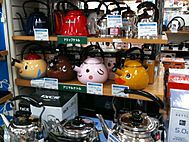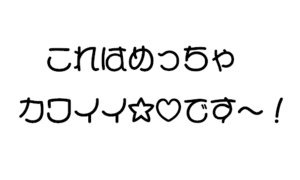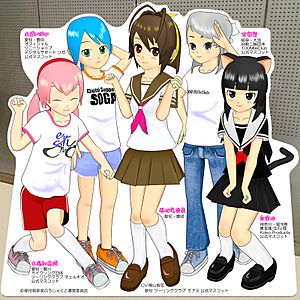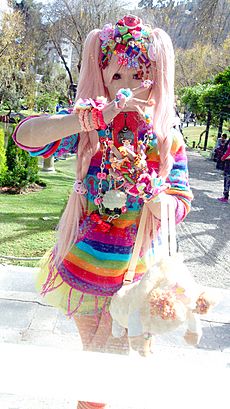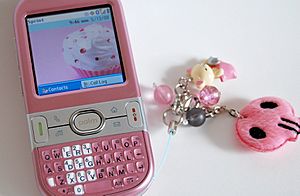Kawaii facts for kids
Kawaii (pronounced kah-wah-ee) is the Japanese word for "cute" or "adorable." It describes a big part of Japanese culture. This includes things like charming objects, people, and even non-human characters. Think of cute handwriting, certain types of manga and anime, and famous characters like Hello Kitty and Pikachu from Pokémon.
The idea of cuteness, or the kawaii style, is very important in Japanese popular culture. You can see it everywhere. It's in entertainment, clothing, food, toys, and even how people look and act.
Contents
What Does Kawaii Mean?
The word kawaii comes from an old Japanese phrase. It used to mean "one's face is glowing," often referring to blushing. Over time, its meaning changed to "cute" or "adorable." It's usually written in hiragana as かわいい. But it can also be written with kanji as 可愛い. These kanji characters mean "able to love" or "lovable."
How Kawaii Became Popular
Early Ideas of Kawaii
The first idea of kawaii appeared in a very old Japanese novel. It was called The Tale of Genji, written in the 11th century. Back then, kawaii meant something more like "pitiable" or "sad." Later, during the Shogunate period, the word started to include women. This was because people began to see women as gentle and calm.
Cute Handwriting Styles
In the 1970s, the kawaii style became very popular. It even inspired a new way of writing. Many teenage girls started writing sideways. They used mechanical pencils that made thin lines. This was different from traditional Japanese writing, which was vertical and had varying line thickness.
These girls also wrote in big, round letters. They added small pictures like hearts, stars, and emoticon faces. This made the writing hard to read. Because of this, many schools banned the style. But by the 1980s, this "cute" writing appeared in magazines and comics. It was also used on product packaging, especially for toys and "cute accessories."
A researcher named Kazuma Yamane studied this cute handwriting. He called it "Anomalous Female Teenage Handwriting." Other names for it included "round writing" (marui ji) and "kitten writing" (koneko ji). He found that teenagers created this style themselves. It was an "underground trend" that started before comics used rounded writing.
Cute Products and Characters
The idea of cute fashion in Japan goes back a long way. Some say it started in the Edo period with popular netsuke carvings. An artist named Rune Naito helped start the kawaii culture. From the 1950s to the 1970s, he drew "baby-faced" girls and cartoon animals for Japanese girls' magazines.
Because of this growing trend, companies like Sanrio created cute products. One example is Hello Kitty. Hello Kitty was an instant hit. The love for cuteness then grew into other areas. Recently, Sanrio has made kawaii characters with deeper personalities. These appeal to older fans. Examples include Gudetama and Aggretsuko. People love these characters for their unique quirks and cute looks.
The 1980s also saw the rise of cute Japanese idols. Seiko Matsuda was one of them. She helped make the trend popular. Women started to copy her cute fashion and gentle ways. This style showed the innocence of young girls.
Kawaii Style and Looks
Cute Looks for Everyone
In Japan, being cute is fine for both men and women. Some Japanese women try to act cute to attract men. A study found that Japanese women in their 20s and 30s liked a "cute look" with a "childish round face." Women also try to look innocent to seem cuter.
Having large eyes is a way to show innocence. Many Japanese women try to make their eyes look bigger. They might wear large contact lenses or false eyelashes. They also use dramatic eye makeup. Some even have a type of surgery called double eyelid surgery.
Japanese Idols
Japanese idols are young media stars. They are usually in their teens or twenties. They are seen as very attractive or cute. For a few months or years, they appear often in the media. They might be singers in pop groups, actors, TV personalities, or models. Examples of popular idol groups include Speed, Morning Musume, AKB48, and Momoiro Clover Z.
Kawaii Fashion Styles
Lolita Fashion
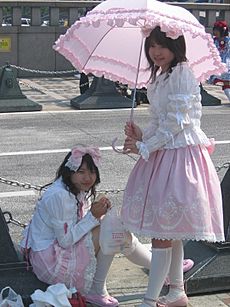
Lolita fashion is a well-known style in Japan. It's based on Victorian fashion and the Rococo period. Girls mix these old styles with their own ideas. They sometimes add gothic elements to create a "porcelain-doll" look. Girls who dress in Lolita fashion want to look cute, innocent, and beautiful.
They achieve this look with lots of lace, ribbons, bows, and ruffles. They also wear bloomers, aprons, and ruffled petticoats. Parasols, chunky Mary Jane heels, and Bo Peep collars are also popular.
Sweet Lolita is a type of Lolita fashion. It uses even more ribbons, bows, and lace. It often features pastel and light colors. Big bows or bonnets are common headwear. Lighter makeup is sometimes used for a more natural look. Curled hair extensions and eyelash extensions also help create the baby doll look.
Themes like fruits, flowers, and sweets are often seen on the fabrics of dresses. Purses might be shaped like hearts, strawberries, or stuffed animals. Baby, the Stars Shine Bright is a popular store for this style. It often uses these themes.
Decora Fashion
Decora is a style known for wearing many "decorations." People who follow this trend wear lots of colorful hairpins, bracelets, rings, and necklaces. They layer many accessories on their outfits. This fashion often looks childlike. It also includes toys and colorful clothes.
Kimo-kawaii
Kimo-kawaii means "creepy-cute" or "gross-cute." This style started around the 1990s. Some people became less interested in cute and innocent characters. They started to like things that were a bit creepy or gross. This style is often achieved by wearing creepy or gross clothes or accessories.
Kawaii for Men
While kawaii fashion is mostly for women, some men also take part. It's rare for men to wear masculine kawaii accessories. Instead, they often dress up as kawaii women. They wear wigs, false eyelashes, makeup, and kawaii female clothing. This is mostly seen in male entertainers, like Torideta-san, a DJ.
Japanese pop stars and actors often have longer hair. Men are also seen as wanting a youthful look. Both Japanese men and women are influenced by the idea of kawaii in some way. They try to be attractive in a way that society accepts.
Kawaii Products and Influence
Everyday Products
The idea of kawaii has influenced many products. This includes candies like Hi-Chew, Koala's March, and Hello Panda. Cuteness can be added to products with features like hearts, flowers, stars, and rainbows.
You can find cute elements almost everywhere in Japan. From big companies to small shops, and even government offices. Many businesses use cute mascots to promote their products and services. For example:
- Pikachu from Pokémon is on the side of some ANA passenger jets. These are called Pokémon Jets.
- Asahi Bank used Miffy, a character from a Dutch children's book series, on some of its ATM and credit cards.
- Japanese prefectures and cities have cute mascot characters. These are called yuru-chara. They help promote tourism. Kumamon and Hikonyan are very popular.
- The Japan Post has a cute mailbox mascot. They also use other cute mascots for their services.
- Some police forces in Japan have their own cute mascots. These sometimes appear on police boxes (kōban).
- NHK, the public broadcaster, has cute mascots. Domokun, a unique-looking mascot, became famous worldwide. He appeared in Internet memes and fan art.
- Sanrio, the company behind Hello Kitty, runs the Sanrio Puroland theme park in Tokyo. Sanrio's characters bring in over $1 billion a year. It's the most successful company to use the cute trend.
Cute can also describe a person's fashion sense. This often includes clothes that look like they are for young children, but in adult sizes. These clothes make the person wearing them look cute. Ruffles and pastel colors are common. Accessories often include toys or bags with anime characters.
Kawaii Around the World
In recent years, kawaii products have become popular outside Japan. They are popular in other East and Southeast Asian countries. They are also growing in popularity in the US. This is especially true among anime and manga fans.
Sebastian Masuda, a designer, brings the kawaii style from Harajuku to Western markets. He believes that "kawaii" can "save the world." The spread of kawaii happens through modern art, media (audio, visual, written), and Japanese youth fashion.
Japanese kawaii is seen as a global trend. This is because it makes cultural products "cute." This idea aims for a global market. It leads to many different uses and meanings in other cultures.
The spread of Japanese youth fashion and "kawaii culture" is often linked to Western society. But with countries like China, South Korea, and Singapore growing economically, kawaii products have shifted back to the East. In these Asian markets, the kawaii idea takes different forms. It changes depending on who it's for.
For example, Taiwanese culture has embraced kawaii. The government even uses it. The "A-Bian" doll was created to help promote democracy. It also helped build a shared identity for Taiwanese people. These dolls are kawaii versions of sports figures, famous people, and even politicians. Politicians use kawaii images to promote themselves and get votes.
Japanese "kawaii culture" has also affected young people in Singapore. Japanese culture became popular there in the mid-1980s. This was when Japan became a major economic power. Kawaii has grown from children's TV shows to an internet sensation. Young people in Singapore often copy Japanese fashion. They learn Japanese and buy Japanese products.
East Asian countries like Mainland China, Hong Kong, Taiwan, and South Korea, and Southeast Asian countries like Thailand, either make kawaii items for the world or have websites for kawaii youth culture. Kawaii has grown to include kawaii websites, homepages, browser themes, and social media pages. While Japan is where kawaii started, artists and businesses worldwide are copying the kawaii theme.
Kawaii has become a global trend. The internet has helped kawaii reach new levels of popularity. Japan's image has changed from being known for serious rock gardens to being known for "cute-worship."
In 2014, the Collins English Dictionary in the United Kingdom added "kawaii" to its dictionary. It defined it as a "Japanese artistic and cultural style that emphasizes the quality of cuteness, using bright colours and characters with a childlike appearance."
Images for kids
-
JNR Class C11 locomotive repainted as Thomas the Tank Engine, Japan, 2014
See also
 In Spanish: Kawaii para niños
In Spanish: Kawaii para niños
- Aegyo
- Camp (style)
- Chibi (slang)
- Ingénue
- Kawaii metal, Kawaii bass (Music genre)
- Yuru-chara



